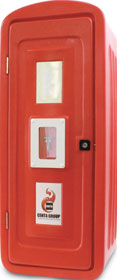

The Centa Group encourages organisations in all sectors to have the correct equipment in place to comply with stringent health and safety regulations.
“A fire risk assessment helps identify potential fire hazards and risks in a property which is critical in every industry,” says Duncan Boyes, chairman of the Centa Group. “Acting on a fire risk assessment in compliance with the Department of Labour’s Health and Safety Act, can save lives and possibly a property from the devastating consequences of fire.
“The Centa Group focuses on five steps when conducting a risk assessment. These are identifying the fire hazard, recognising people at risk, evaluating risks, recording findings and reviewing and revising the situation. In addition a comprehensive summary format is provided to clients.”
The fire risk assessor’s first step in identifying a fire hazard is to determine potential sources of ignition and fuels. For a fire to occur, three elements are required – source of ignition, fuel and oxygen – in most premises, fire hazards are found in the source of ignition and fuel.
Potential sources of ignition include natural flames from stoves, hot surfaces like lighting and heaters, welding, friction from conveyor belts, sparks from grinding and deliberate ignition. Potential sources of fuel are solids (textiles, paper and wood), liquids (petrol, diesel, thinners and paint) and gases.
Centa’s fire risk assessment for people focuses on the likely speed and growth of a fire, the number of people in an area, fire warning arrangements and a clearly defined plan of how people should make their escape.
If there is a fire, the greatest danger is the spread of fire, heat and smoke through the premises. The main risk to people is smoke and products of combustion, which can very quickly harm those trying to escape.
The next step of fire risk assessment, evaluating the risks in an establishment, also encompasses taking into account measures which have already been put into place and the consideration of additional control measures that will further reduce potential risk.
Further control measures include reducing possible ignition, minimising fuel loads and assisting people to escape. Other important measures are removing the hazard to another area, the installation of a fire detection and alarm system and providing appropriate fire fighting equipment, like additional fire extinguishers, fire suppression systems and sprinkler systems. Training staff in safe work practices and efficient housekeeping forms is also an important part of fire protection.
There are always various solutions to reducing a fire risk, depending on the nature of the situation, which is why Centa’s assessments include an action plan to monitor and review all fire safety arrangements.
The accurate recording of findings includes information on who is at risk, official compliance to national acts and standards, documentation of the adequacy of existing control measures, additional measures required to reduce risk to an acceptable level and the inclusion of a simple floor plan of the establishment.
Fire risk assessments are ongoing processes that need continuous monitoring and auditing to ensure existing control measures are maintained and new measures are introduced when required.
For more information contact The Centa Group, +27 (0)31 569 1175, [email protected], www.centa.co.za
© Technews Publishing (Pty) Ltd. | All Rights Reserved.